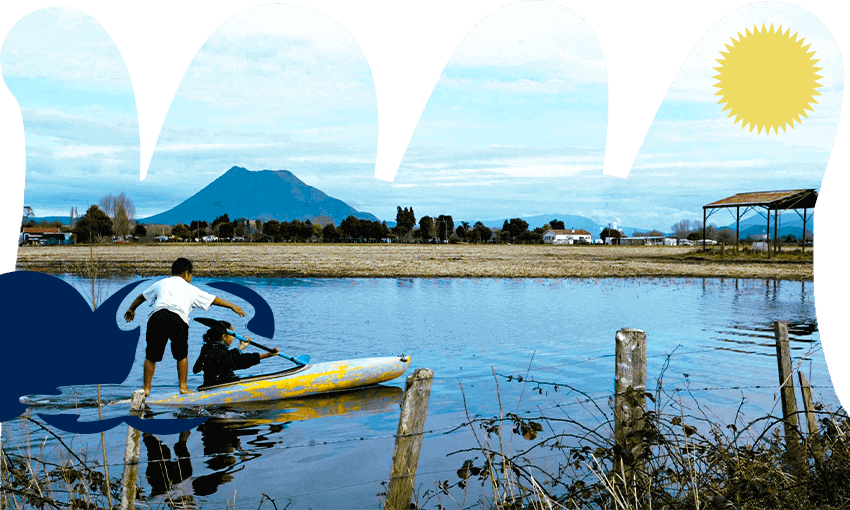Flooding has long impacted Aotearoa, but the recent past has seen more, bigger flood events than ever before. What’s changed?
The rains came fast and hit hard. Downpours, brought on by ex-tropical cyclone Debbie, battered the Bay of Plenty region.
It was more than the small town of Edgecumbe could bear.
After days of straining against rising river waters, the concrete floodwall separating the Rangitāiki River from the town leaked and eventually burst, unleashing cascades of water. Edgecumbe became awash with flooding and debris.
At around 8:30am on the morning of April 6, 2017 those living in the town were told to leave their homes to seek higher ground. Some never returned to those homes.
Edgecumbe isn’t an isolated event. New Zealand’s history is riddled with severe floods – around 100 over the past 60 years, and nine in the past 14 months alone – which have washed through townships and displaced families and entire communities.
With such a full history of floods, were there signs that they were going to happen? And how does climate change play into how predictable, and severe, future floods are going to be?
This content was created in partnership with Tower Insurance. To learn more about how flood risk works and to speak to an expert about your own property risk profile, get started by clicking here.
The timeline of events leading up to April 6 seem straightforward: heavy rain, swelling river, stopbank burst. But according to the late Sir Michael Cullen, who led a 2017 independent review of the flood, the situation was “complex”.
Floods are caused one of three main ways. Rain or snow melt can cause rivers to swell and overflow, also called a fluvial flood; rain can hammer concrete surfaces and overwhelm stormwater systems, known as pluvial flooding; or ocean waters can sweep up high onto land: coastal flooding.
Three days before the Edgecumbe flood, MetService had issued a warning for heavy rain, culminating in predictions of 200 to 350mm of rain in less than two days. The other factor at play was that the previous month had been very wet as well, meaning soils were already soaked from high rainfall.
Heavy rain and wet soil combined to cause both the Whakatāne and Rangitāiki rivers to swell, with the Rangitāiki about 20% more full than during the previous 2004 flood.
The weather signs were there; how the region dealt with their consequences came down to its flood management plan.
Edgecumbe’s main lines of defence were the nearby Matahina dam, which could store some of the floodwaters if water was drained out of Matahina lake; the Reid’s floodway, which would divert floodwaters away from the city; and its various floodwalls along the river, which should have held the floodwaters back.
The 2017 report identified that Trustpower, which was in charge of operating the dam to lower lake levels ahead of heavy rain, was slow off the mark and communication between the local council and the organisation broke down at times. It’s unlikely though that changes would have prevented the floodwall from breaching, the report concluded.
The floodway was outdated and undergoing a years-long upgrade, including widening the floodway to accommodate more water. Design issues, landowner negotiations and dodgy modelling of its capabilities all contributed to delays in getting the floodway upgrade completed by 2014. If it had been, it’s likely there would have been less pressure on Edgecumbe’s last line of defence: its floodwalls.
Wedged between the town and the river sits the College Street floodwall, adorned with brightly-coloured paintings of fish and hillsides. The wall had already withstood earthquakes, previous floods and slumping of the river bank, creating cracks in its foundation and leaks in its face.
Twenty minutes before it burst, residents noticed water seeping from the wall. That seep turned into a fountain up to a metre tall spurting from the concrete. One fountain turned into several. Finally, the wall cracked open “like two gates” unleashing water upon the town.
After some 160 pages, the report concludes that the framework that manages flooding events, the 1970 Rangitāiki River Flood Scheme, is past its use-by date. It made several recommendations about how to beef up the scheme and infrastructure, including the floodwalls and floodway.
But not all floods can be traced back to something as dramatic as a concrete barrier failing. Northland’s 2020 flood saw rivers and streams swell but also water collecting on concrete surfaces and in low lying areas.
After months of droughts, more than 200mm of rain fell on the region, causing slips that closed the main highways and water to pool and eventually inundate homes.
Both floods would have emotional, legal and economic consequences. Years later, school children in Edgecumbe would cower under tables when it rained heavily. Other residents would speak about how traumatic and lonely the past few years have been.
Homes were left uninhabitable, some caked in mud and debris; others were completely washed away or their foundations destroyed. Insurance claims for lost or damaged homes and belongings totaled in excess of $91 million in Edgecumbe and $37 million in Northland.
Various factors contribute to a home’s flood risk. According to Tower Insurance, these can range from the number of floors to the building materials and flow of water. New technology developed with analysis from Risk Management Solutions and brought to New Zealand by Tower gives homeowners and insurers a much clearer picture of the individual flood risk of a property, says Tower CEO Blair Turnbull.
“The benefit of using the RMS model is that it is so detailed that neighbouring properties can have very different ratings, depending on the camber of their land, whether they have a flood wall, and other factors.”
New Zealand has been rated one of the worst countries in the world for natural disaster risk, and this modelling helps homeowners and potential owners to make the best decisions for themselves. Each customer is given a low, medium, high or very high rating for their flood risk, which also brings down insurance prices for those in lower-risk categories.
“Ninety per cent of Kiwis told us that access to flood risk data about a house they are looking to buy may change their thinking about the property in some way. We also know that only one in three Kiwis feel very confident that they have the right level of insurance for their current house to cover the risk of flooding by waterways and rainfall,” says Turnbull.
In the Edgecumbe and Northland floods, it was not just homes that were lost, but many farming businesses too. Farmers lost fences and animals, and had a huge cleanup job on their hands, all while trying to keep their animals free of diseases spread by dirty floodwater.
After each event, New Zealand’s scientists have issued a stark warning: be prepared because extreme floods are going to happen more often because of climate change.
The 2017 Edgecumbe report stated there’s “near-certainty that climate change is leading to more severe and more frequent extreme weather events of the sort that occurred in April [2017]”.
According to Iain White, professor of environmental planning at Te Whare Wānanga o Waikato, The University of Waikato, “those big, strong, short, sharp dumps of rain we get a lot of recently, we’re due to get more of them”. That’s because as the atmosphere warms, it can hold more moisture, which then falls to the earth in big dumps.
It also means atmospheric rivers, large pools of concentrated moisture in the atmosphere, are more likely. Rising sea levels means coastal areas are more vulnerable to flooding. And warmer ocean temperatures are a great starting point for tropical cyclones or hurricanes, like the one that fueled the heavy rains near Edgecumbe. Climate change is set to make those storms more intense, the National Institute of Weather and Atmospheric Research (Niwa), Taihoro Nukurangi predicts.
Scientists are already able to see how much climate change contributes to recent New Zealand flooding events. They create models of what a weather event would have been like if greenhouse gases weren’t higher, as they are today. For example, almost half the risk associated with the Northland floods could be pinned to climate change.
It’s called attribution science and researcher Sam Dean says it has a big role outside of science. “Attribution has a really strong role in communicating with people the idea that climate change is the here and now. It’s not something for the distant future,” he told Stuff.
But it’s tricky. As Edgecumbe and Northland demonstrate, it’s an interplay between climate change, the weather it creates, built structures and people’s responses to circumstances and attitudes towards risk.
“It’s quite uncertain,” says White. “One of the things we’re trying to do is bring knowledge together and understand more. So we get modellers working side by side with planners so that we can make better decisions now.”
That side by side approach, White hopes, will save people heartache, homes and money in the long run.


